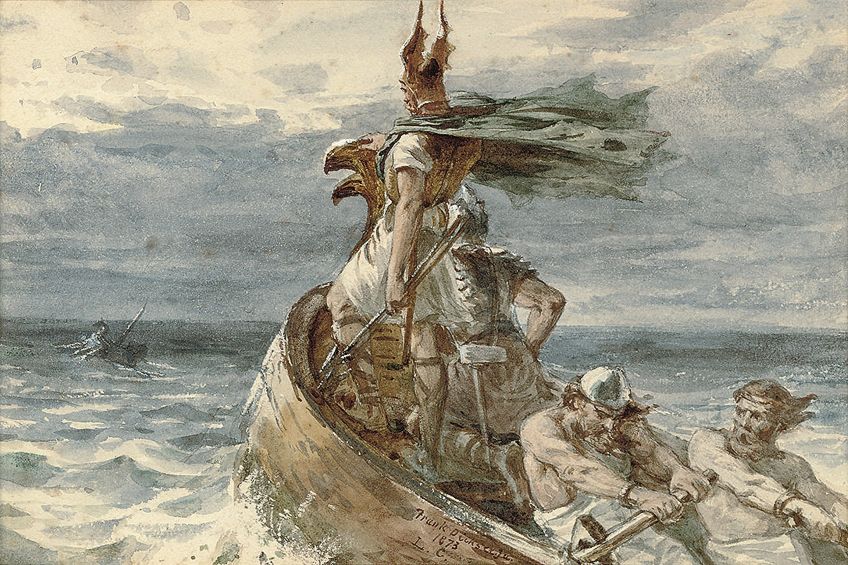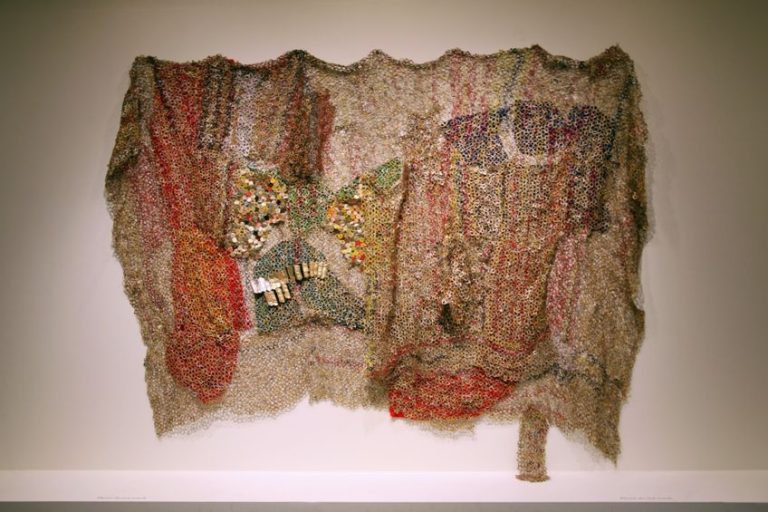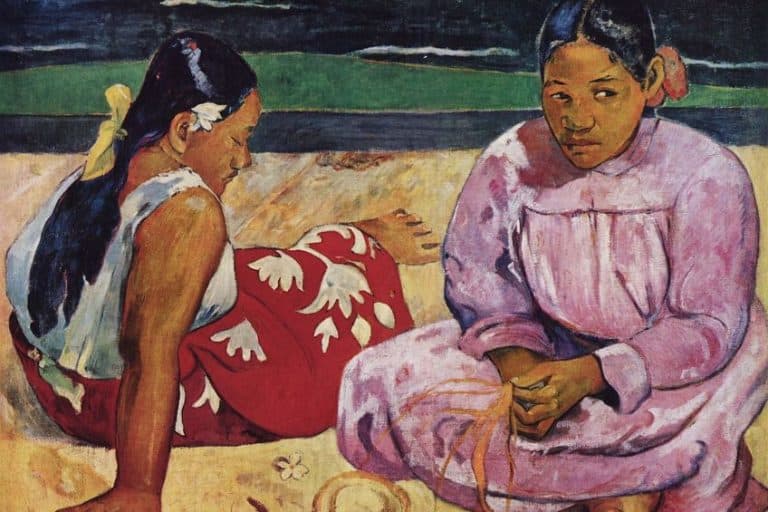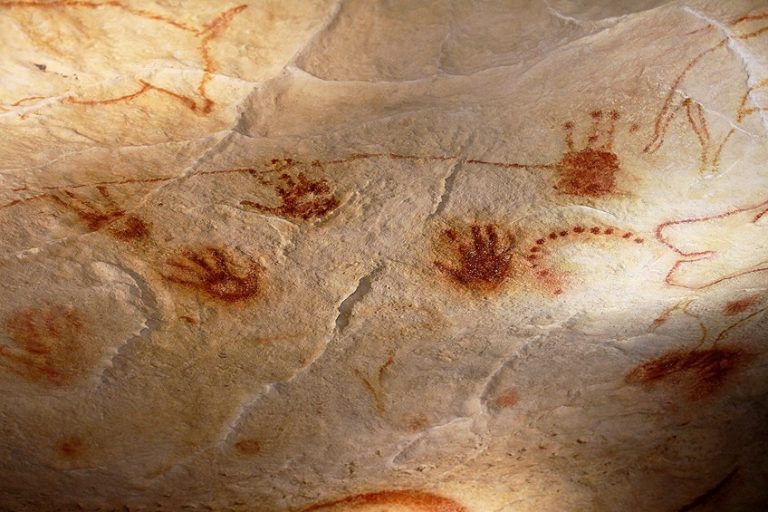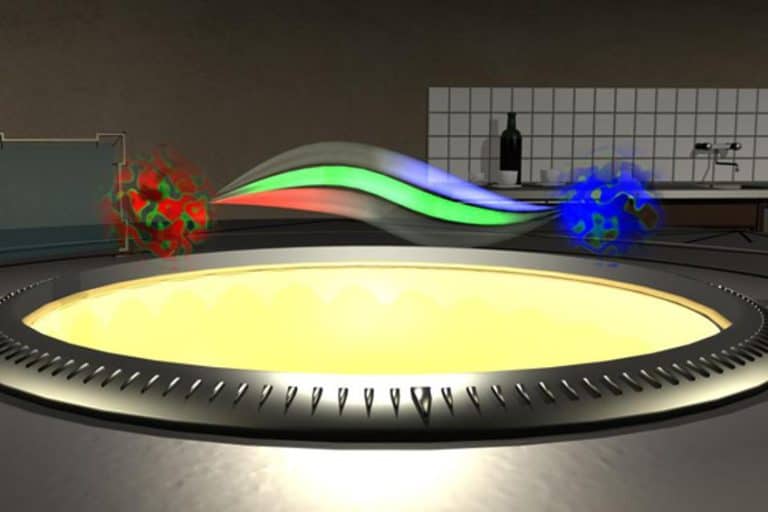Viking Art – The History of Norse and Viking Artwork
While some know them as pirates, seafarers, invaders, raiders, pillagers, barbarians, savages, and great bearded men, most of us know them as the Vikings. They have received quite an infamous reputation in history, and rightfully so because they did invade and pillage most of European lands and towns. However, they left behind more than ruins in their seafaring trails, but tales of a culture rich in history, mythology, and art.
The Northmen: A Viking History
Before we discuss Viking Art, it is useful to understand who these “Northmen” were. The term “Northmen” was used to designate the Norsemen, otherwise, the Norse people, who inhabited medieval Scandinavia, a collective of the Northern European countries of Denmark, Norway, and Sweden.
The Vikings were Norsemen and a group of seafaring “warriors” who invaded Europe and prominent areas like the British Isles – they also went as far as Russia and Canada in their conquests. It is important to understand that the Vikings were only a part of the whole of this Norse culture and there was more to them than the modern-day understanding of them as violent, barbaric “pirates”.
The term “Viking” has been given multiple meanings over the ages and a general understanding of its origins will provide better context. “Viking” has been used as a noun and verb in certain contexts. It is particularly defined as “pirate” and derives from the Old Norse word vikingr.
The word vikingr is also derived from the word vík meaning “inlet” or “bay” and the suffix –ingr connotes someone who “belongs to” – the meaning can loosely be given that it is someone of the bay, which is where the Vikings were perceived to come from when they crossed the seas to invade new lands.
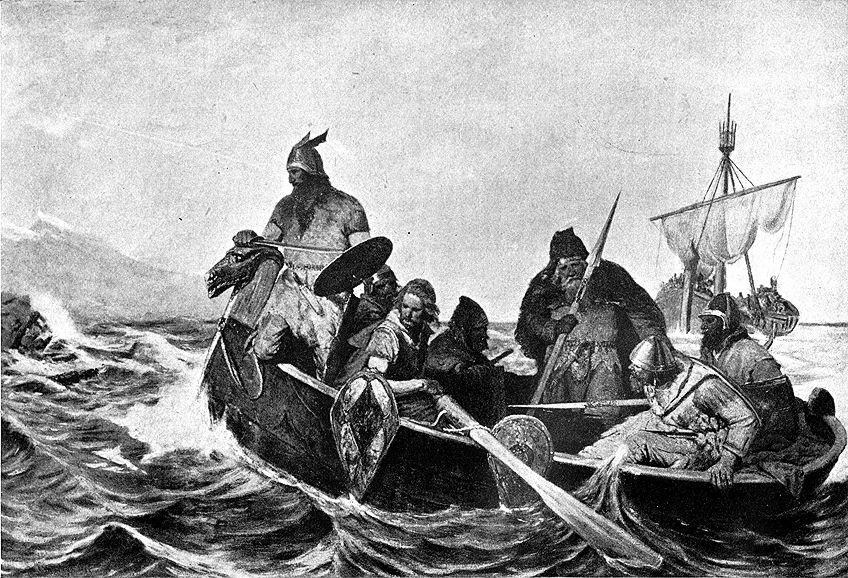
The Viking Age started around 793 to 1066 CE with the notable 793 CE invasion of the Holy Island of Lindisfarne in Northumberland, North East England. This was the onset of the Viking invasions and the severity of what these “Northmen” were capable of. They pillaged and killed the people from the island and desecrated what was considered holy without any reverence to the Christian religion practiced throughout England.
Although the Vikings raided many coastal areas, they also invaded inland. It was in 799 CE when they invaded the monastery of St. Philibert on the tidal island, Noirmoutier, in France – this was recorded as the first continental attack. The Vikings reached far and wide across Europe and were involved in many wars and trades in different countries.
Their settlements were placed widely throughout the British Isles in places like Scotland and Ireland, they also founded, traded, and settled in cities like Dublin. Their expansion also reached into Russia and North American countries like Greenland and the northern part of Newfoundland in Canada.
The Viking culture, or Norse culture, was diverse and not solely designated to pillaging and raiding. They were also farmers and traders with skills in blacksmithing, weaving, carpentry, music, crafts, and more.
The Viking longships also became one of their most innovative constructions, used to navigate the seas and take them to distant lands. It was a significant part of the Viking culture as most of their expeditions required considerable seafaring navigation. The longship’s design was ideal for lightness and speed on the ocean. It was long and narrow in structure with oars running along the boat’s length intended for rowers.

The longships were also versatile, each end was designed similarly, which minimized the effort of ever needing to turn a boat around, furthermore, the boat’s draft was shallow, enabling it to be on shallow waters. There were varying types of longships and made from different types of wood depending on the area of construction.
The Vikings’ history is rich with religion and mythology, and there are two primary texts that provided a framework about the Norse (Scandinavian) history overall. The Eddas are Icelandic manuscripts, namely, the Prose Edda and Poetic Edda. The Prose Edda’s origins go back to during the early 1200s CE and the Poetic Edda’s origins go back to the late 1200s CE.
Both texts were written by different authors; the Prose Edda was written by Snorri Sturluson, a poet and historian from Iceland. The author for the later text is still unclear and with many theories pointing to the work compiled by various poets, who also passed down the stories orally.
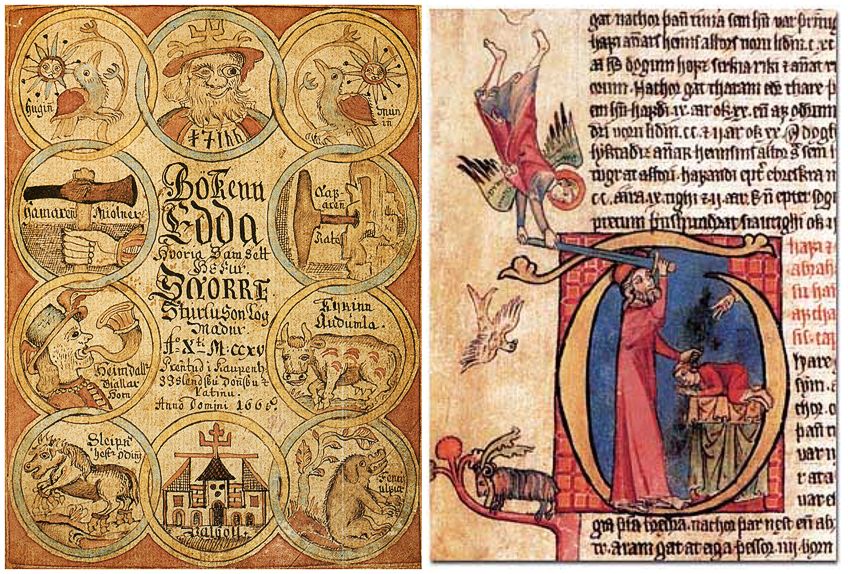
Viking Artwork
Some of the main characteristics of Viking Art include its functionality. This is evident in the wide selection of art (or ornamentation) portrayed on various everyday objects like drinking vessels, armor, weapons, storage containers, jewelry, ship equipment, and parts like oars, furniture, and much more. Viking artwork, or more broadly Norse artwork, combined with their daily life and represented their beliefs about the world.
The Viking culture had a Pagan belief system, which was dominantly the Scandinavian belief system. However, the Vikings would have encountered Christianity during their raids of various monasteries along the coasts of England. The Viking culture eventually adopted the Christian belief system. The Scandinavian belief system is known for its Norse Mythology with gods like Odin and Thor. These are also mythological characters alive today through pop culture and modern Viking concept art.

Another important characteristic of Viking Art includes the utilization of symbolism. Objects appear decorated with elaborate abstracted designs of animals, birds, humanoid figures, and patterns. A common pattern seen in Viking design is the intertwining of shapes or spiral-like motifs, this is also referred to as Norse knotwork.
Norse knotwork was a common motif within Norse Art in general and bore influences from Celtic Art knotwork, however, there are differences between the two design styles. For example, Celtic knotwork (Icovellavna) depicts more lines flowing in a seemingly ordered pattern. Norse knotwork shares similar design patterns, but also includes other visual motifs like animals, faces, or other significant symbolic objects.
Most of Norse Art, and similarly Viking artwork, was skilfully carved in wood. In fact, woodworking was an important occupation and skill in Viking culture. Other materials utilized were metals, stones, ivory, bone, including textiles. We notice the Viking designs on many of their objects, including objects for burials and their seafaring ships.

Viking Art Styles
Viking artwork has been categorized into six distinguishing art styles based on the evolution of the Viking knotwork and design. The styles are also based on the names of where the Viking objects were found. Furthermore, the styles are ordered by their date of occurrence, and it is important to note that these dates overlap with each other (much like the overlapping Viking designs). Below we discuss each style and how the Viking design evolves throughout each.
Oseberg Style (c. 775 – 875 CE)
The Oseberg Style is the first noted style in traditional Viking Art, the name derives from the burial mound discovered at Oseberg, located near the city of Tønsberg, Vestfold County, Norway during 1904 and 1905. The discovery is marked by the founding of the Oseberg Viking longship made of oak wood.
The ship was made for funerary purposes for two women whose skeletal remains were excavated in the burial site. It also included various objects, or “grave goods”, accompanying the burial, these ranged from decoratively carved wooden bedposts, sleighs (or sleds), a wagon made from oak, wooden chests, and various other paraphernalia like wooden buckets with ladles and apples inside, as well as textiles and garments from the buried women.
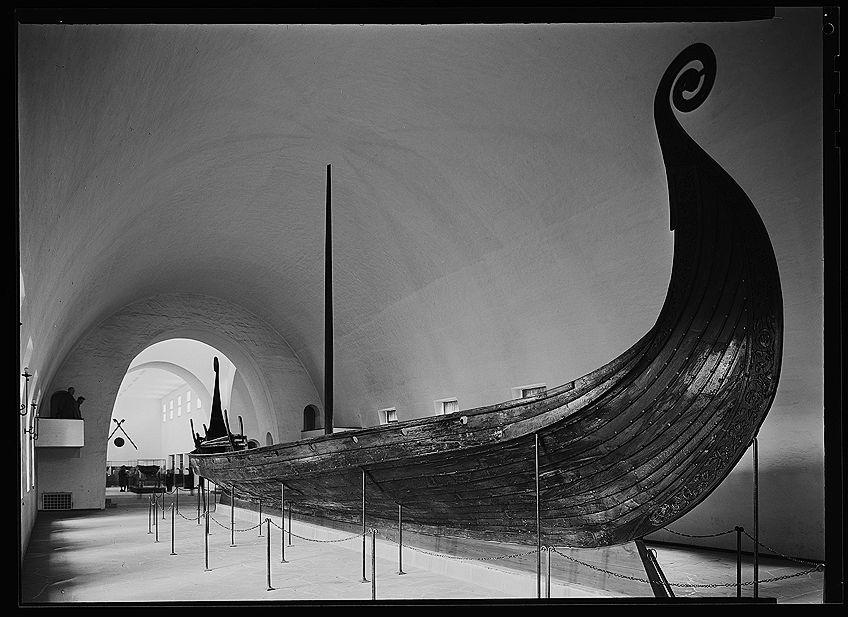
The wooden buckets were made from yew wood with brass inlays, but one bucket stood out from the rest, referred to as the Buddha Bucket, also made from yew with brass handles. Each end of the brass handle is attached to the back of the head of two Buddha-like figures, sitting in what is seemingly a “lotus posture”.
These metal figures are referred to as escutcheons, which are used as decorative and protective metal covers around various functional objects like handles, doorknobs, keyholes, or in this case the bucket’s handles. Furthermore, the torsos of the two figures appear as ornamental squares, decorated in enamel, which is referred to as cloisonné enamel.
What is unique about the Buddha-like figures is their close resemblance to Asian culture, and it is debated whether this was influenced by it, particularly the Buddhist culture.
Scholarly sources indicate it derives from Celtic and Early Christian influences. The figures may, in fact, be representations of the god Cernunnos from Celtic mythology who is often depicted as sitting in a lotus-like posture. The decorated torso also derives from similar Celtic designs.
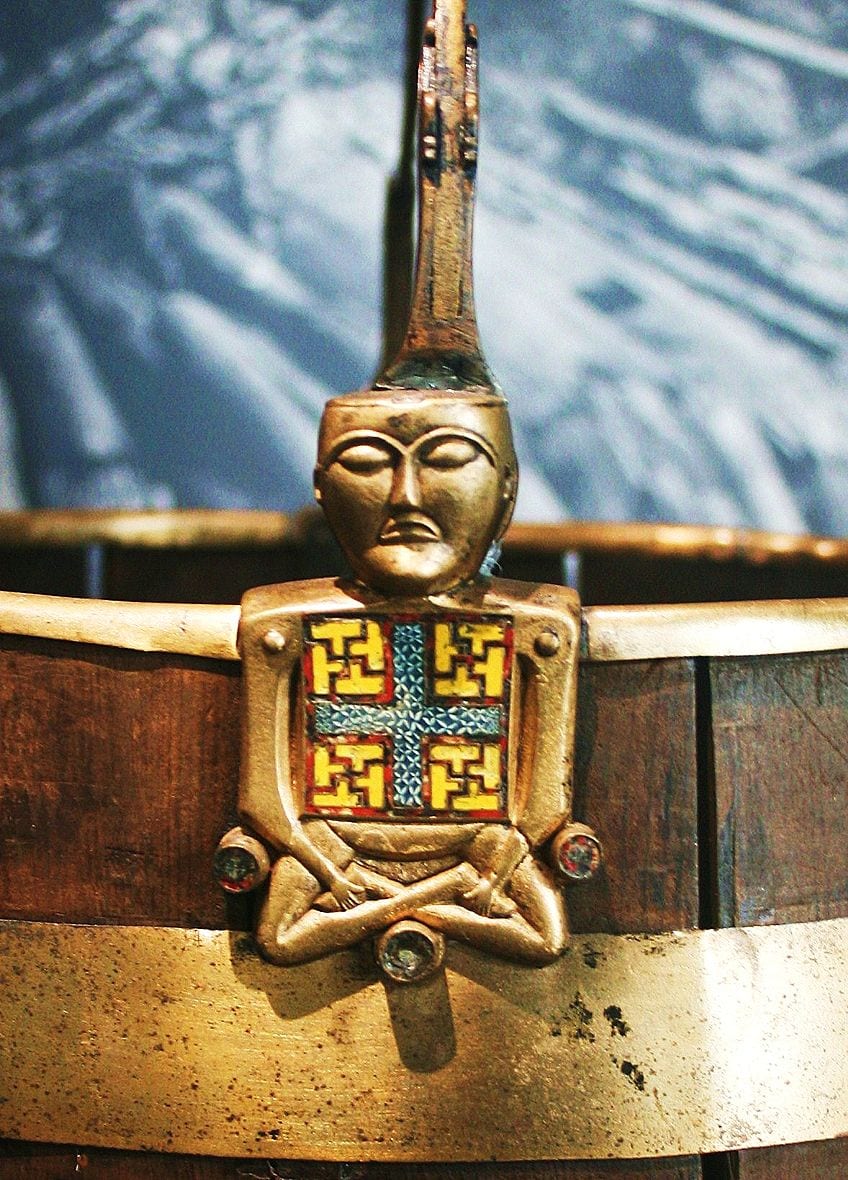
Other decorative elements from the Oseberg Style include the Norse knotwork designs, specifically the “gripping beast” and “ribbon animal” motifs on the ship’s bow (front) and stern (back). These motifs appear as beast-like animals with circles for eyes (often described as “zoomorphic”), interlocking, snaking around one another, and seemingly engulfing other winding parts. This creates a more abstracted and geometric appearance as well as a patterned effect along the ship’s bow.
There are two notable sculptors (otherwise also referred to as “carvers” because of the importance placed on wood carving as a primary skill) prevalent during this period, they are named the “Academician” and the “Baroque Master”. Both artists carved animal head posts, which have been compared in stylistic differences. The Academician is described as having a traditional Viking Art style and the Baroque Master is described as more “innovative” in his style.
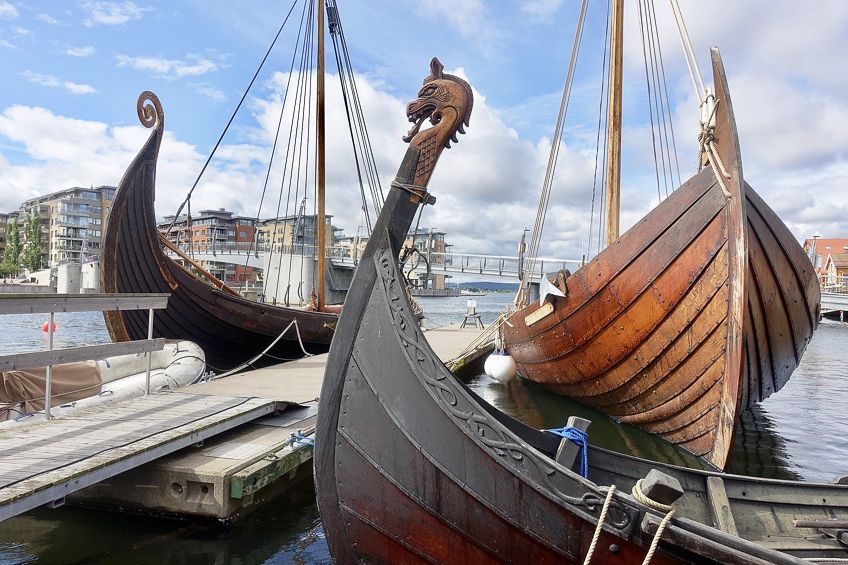
The Academician carved an animal head post, the head appears to be a beast with an open mouth. It is decorated with interweaving carved patterns while the rest of the body is plain wood. The patterns appear more as a singular motif utilized.
The Baroque Master also carved what is referred to as a head post, but it depicts multiple motifs to decorate the head. The decorations also run further down the neck compared to the Academician’s head post. There are more figures and animals intricately carved in overall circular designs.
The Oseberg style is sometimes also referred to as the Broa style due to the finding of 22 gilt-bronze harness mounts in Broa, a town in Gotland, a Swedish island. The harness mounts were found in a grave belonging to a man. The Broa style is often used alongside the Oseberg style.
Borre (c. 850 – 975 CE)
The Borre Viking style was named after the discovery of bronze bridle mounts from a ship’s grave in the Borre Mound Cemetery located in Borre in Vestfold County, Norway. This style is a continuation of the previous style with similarities in the Viking design, however, there are also notable differences compared to the previous style.
We will notice the characteristic “gripping-beast” motif in various objects, but there are other stylistic motifs evident. The various forms are depicted in what is described as tighter arrangements, giving more compactness. This in turn reduces the spaces in the background, this is a notable difference versus the previous style where there were more open spaces in the background.
When we look at the type of figures, or forms, portrayed, they also interlock with the other. The facial features of some of the figures appear with larger, rounded eyes, heads in more triangular shapes, as well as ears that are more pointed. This is evident in an example from Gotland in Sweden, the Silver Disc Brooch.

This brooch has several human and animal-like figures arranged in a circular pattern, some protruding more than others. There are four four-legged animals and four human figures, each arranged in-between the other. The animals appear as if their heads are bending all the way to their back with their tongues licking their backs.
The human figures appear squatted, holding a V-shaped object around their neck area. In an aerial view of this object, we notice the human figures appear to be looking upwards as we notice their full oval (or triangular) shaped faces with rounded eyes and large noses.
Other objects from this style include the Gold Spur with the “ring-chain” pattern on it – a pattern characteristic of this style. The “ring-chain” pattern is also called “ring-braid” and appears as various intertwining and interlacing circles.
The Borre style became prominent in other areas not only restricted to Scandinavia, for example, the British Isles and Baltic areas like Russia.
Jellinge (c. 900 – 975 CE)
The Jellinge Viking style is often characterized as being continuous with the Borre style, and it is named after a silver cup from a royal burial mound in the town called Jellinge in Denmark. The silver cup depicts the characteristic S-shaped animal with a head and large round eyes. The animal creatures surround the whole outside circumference of the cup, interlacing with the other to form a fluid patterned effect.
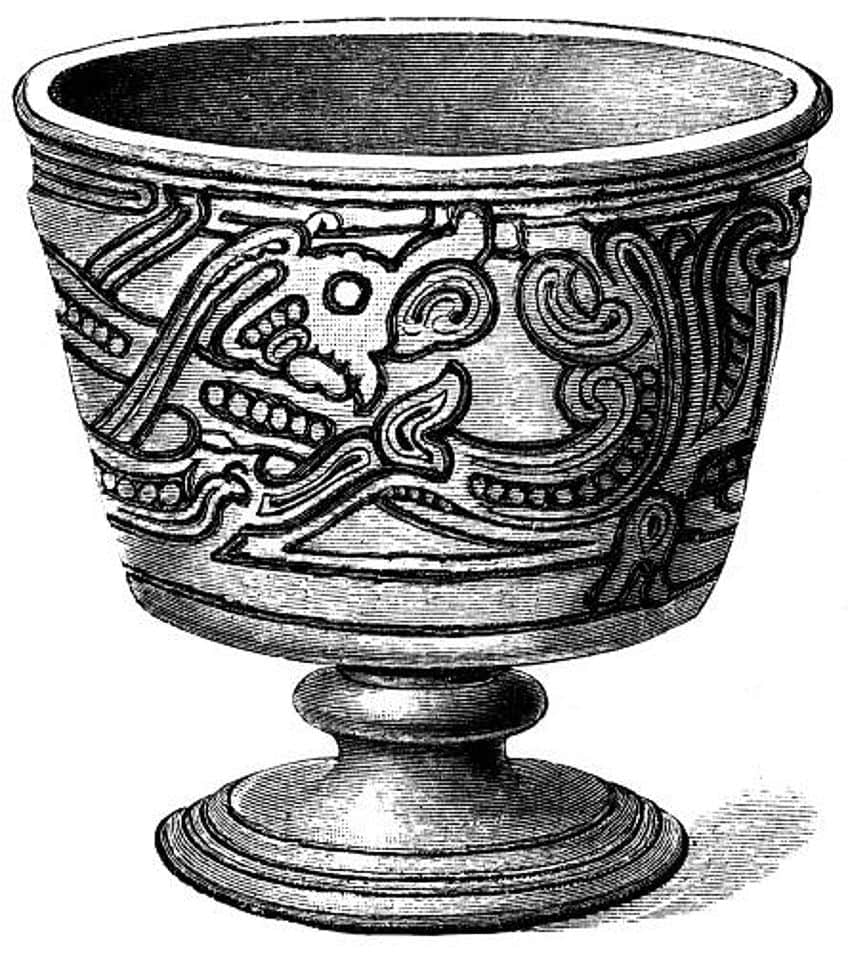
We will also notice their serpentine bodies curling around the cup have dots in the center or metal-like “beading”. When we look at their heads, they appear to have large lips curling upwards with a long ponytail-like protrusion interweaving behind their bodies to create a pattern.
Furthermore, these long “ribbon-animals” also appear to have legs or arms with a paw or hoof as their appendages, similar to the “gripping-beast” motif. Some sources indicate these appear like “mitts”. The hip joints are represented as spirals, like that of the Borre style, however, unlike the Borre style, the Jellinge style offers more of an open background with more simplified figures and animals.
Mammen (c. 960 – 1000/1025 CE)
The Mammen Viking style was given the name from an ax head discovered in a grave in Mammen Village in Denmark. The ax head is notable for its inlaid designs, which are done in silver. This also suggests it was used for ceremonial purposes and not functional purposes, as axes were widely utilized by the Viking culture (or the Norse culture in general).
The decorations on the ax head appear on both sides. One side appears mainly with interlacing tentacle-like formations, these are also described as “foliate” patterns. The other side depicts what appears to be a giant bird-like figure with similar tentacle-like (foliate) formations intertwining with it.
Again, we see the large spiral shape at the hip joint with a stylized head and round eyes. The entire bird-like figure and “foliate” patterns have dots (“beading”) running through the middle as well as decorating the body (upper and lower “torso”) of the bird. This composition also allows more background space, similar to the Jellinge style before it.
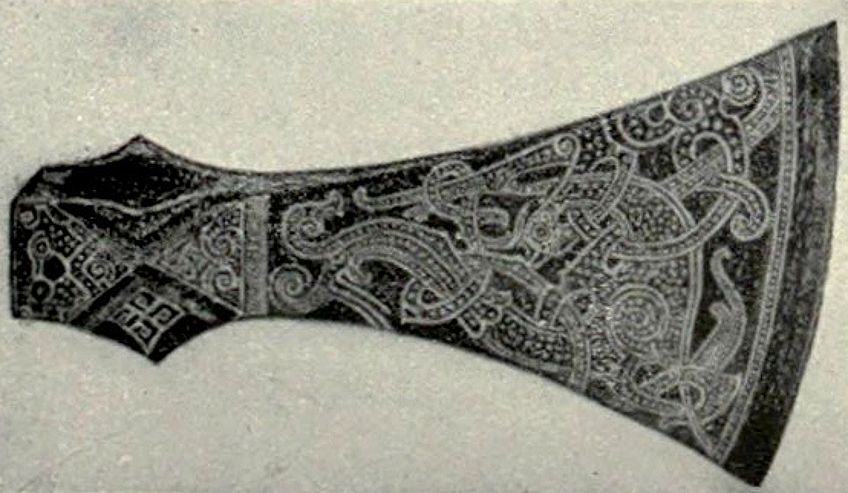
Reproduction of an ax head inlaid with silver, from Denmark (Viking Age); Unknown author Unknown author, Public domain, via Wikimedia Commons
One of the primary characteristics of this style is seen on the large-scale runestones called the Jelling Stones, which were discovered in Jelling town. These stones have become the cornerstones of the Mammen style due to the significant motif referred to as the “Great Beast”.
On the one side of the stone, we notice a large animal or hybrid of an animal due to its many different features of different animals. For example, its head is adorned with a set of what appears to be antlers and two small, pointed horns; along the neck, we notice a mane of hair as we find on a horse’s neck; the feet, and what we assume are hooves, appear as claws.
The tail of the hybrid creature curls upwards into an elaborate display of quasi-emblematic curls. We also notice a serpent-like figure around the body, neck, and tail of the creature. The major mobility, hip, areas are depicted with the characteristic spiral shape. Lastly, the figure’s head appears triangular (with a triangle as a snout and a circle as an eye) and its mouth seems to be open with a large curling L-shape coming from it, which could also be a continuation of the antlers above its head.
The “Great Beast” is often referred to as representing power, which is understandable when placed within the context of how these Jelling stones came to be. The above-mentioned Jelling stone was erected by King Harald “Bluetooth” Gormsson in honor of his parents when they died. It was also erected to honor and celebrate his victory of being King of Norway and Denmark.
Furthermore, King Bluetooth also introduced Christianity in Denmark with an increased number of people converted – the King himself was a devout Christian. This also explains the other side of the Jelling stone, which depicts the crucified figure of Christ. The inscriptions on the stone give further evidence of the conversion from Paganism to Christianity.
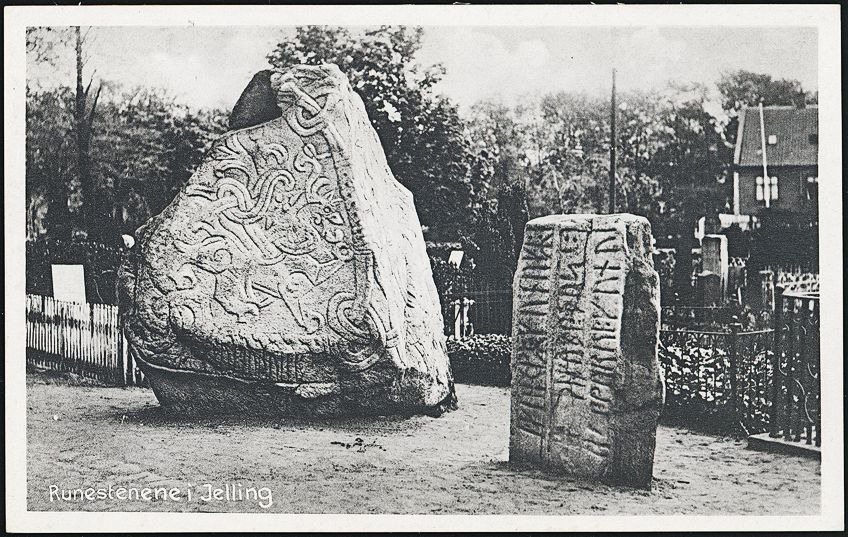
When we look at the Christ figure, we notice his wide and open arms and the familiar tendril-like, sinuous, formations running around his arms and torso (these could also be the same foliate-style we see in other examples mentioned).
Christ’s facial features appear severe in style, depicted as a noticeable elongated chin, two small horizontally planed oval eyes, straight-set lips for the mouth, and an elongated nose. Christ’s overall facial features appear neutral in expression.
Other examples from the Mammen style include two caskets, namely, the Cammin Casket and the Bamberg Casket. During World War II, the Cammin Casket was reported as destroyed during fires in the Cathedral of Saint John, located in Cammin, where it was housed.
The Cammin and Bamberg caskets are similar in appearance, both are chests with lids that are slightly domed. These are made from ivory and bone with bronze strips along the edges and midlines of the chests as reinforcements.
Ringerike (c. 990 – 1050 CE)
The Ringerike style is named after the Ringerike district in Norway. This is also the location where more runestones were erected due to their increase in popularity. Animals and foliate designs appeared thinner without the dots or decorative “beads” in-between, referred to as “double contour lines”. The animals continue to appear beast-like, and struggling with the serpentine creatures encircling their bodies, like the above-mentioned beasts we encountered in the previous styles. There are additional animals included in the stone-carved compositions.

An example of the above is in the carved stone at St. Paul’s Churchyard located in London. Here we see a beast-like animal appearing horse-like, seemingly in a constricted state, overwhelmed by various other figures attached to it. Its head and neck are reared facing behind it with what seems to be its tongue flicking out of its mouth, curling at the end tip.
There is more dynamism in this stone carving due to all the figures filling up the composition. We also notice other animal-like figures near the bottom of the composition holding onto the beast’s legs. Also, we notice the characteristic tendrils with hook-like ends. The major mobility areas on the Great Beast are depicted as spirals.
Another example in this style is the Vang Stone located in Vang, which is part of the Valdes region in Norway. It is a large rune stone with red patterns covering most of the surface. Again, we notice the familiar tendril-like, sinuous, patterns with almost hook-like ends intertwining, reminiscent of the Norse knotwork so characteristic of the Viking culture. The top section of the stone’s composition includes the lion-like animal in its heraldic stance with its mouth wide open as if it is roaring.
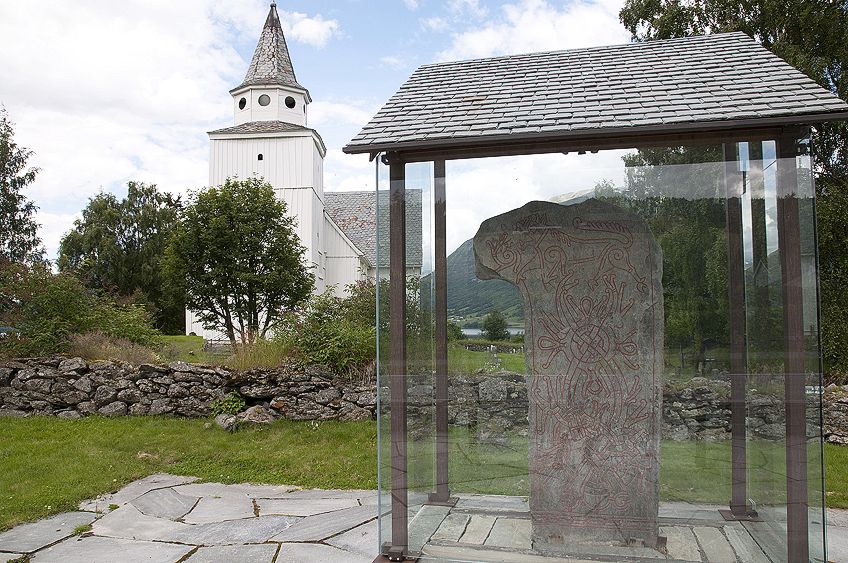
Urnes (c. 1050-1125 CE)
The Urnes Viking style is the last of the categorized Viking artwork styles, and it is named after the Stave Church in the village called Urnes, in the Vestland county in Norway. The church’s northern face depicts carvings done in wood in an elaborate relief style.
Here we see three familiar narrative motifs, namely, the beast-like creature, or “Great Beast”, also described as sharing features to a “Greyhound”, the serpentine figure curling its way around the composition, and thinner tendril, foliate-like, ribbons adding additional stylistic detail.
The primary action taking place is at the bottom of the wooden carving where we notice the beast-like figure and snake, both seemingly biting or gripping the other. The snake’s mouth is around the beast’s neck, and simultaneously the beast’s mouth is around the snake’s neck area. This interplay creates a patterned effect so familiar to the Viking artworks, but it also provides more detail to the narrative and the relationship between these two creatures.
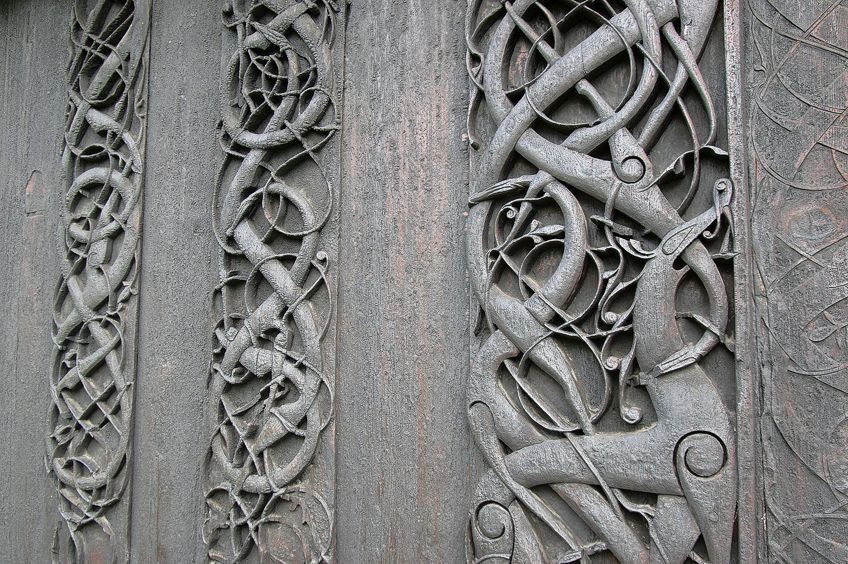
What is different about these styles is that the designs are more refined and sleeker in appearance. We also see a finer delineation of curves and the characteristic spiral that accentuates and defines the hip areas of the four-legged animal appear smaller.
The serpentine figures still have an appendage attached to their bodies, but this appears more streamlined with its joint area highlighted by a spiral. Maybe the adage of “less is more” creates a stylistic difference in this period versus the preceding periods.
The animals are depicted in a finer and more delicate essence of spirals and curves. There appears to be more emphasis on the lack of emphasis placed on portraying the curves and lines in a thicker manner. Furthermore, the eyes are more oval, almond-like, in shape. The four-legged animal has smaller feet compared to the previous styles where it had grabbing (often intimidating) claw-like feet.
This style also occurred in countries like England and Ireland. A popular example is the Pitney Brooch, which was found in Somerset, England, in a churchyard during the 1870s. It is 39 millimeters in diameter and made from gold and copper alloy.
This brooch depicts similar motifs characteristic to the Norse artwork. It portrays the serpentine figure, or snake, intertwined with a slimmer appearing ribbon-like animal. The snake is biting its own body. We can distinguish the snake by the metal beads running along the dorsal (upper) side of its body.
The intertwining animals and foliate designs are kept within the scalloped border of the circular frame of the brooch. The brooch also appears asymmetrical in design, which is another feature characteristic of this Viking design style.
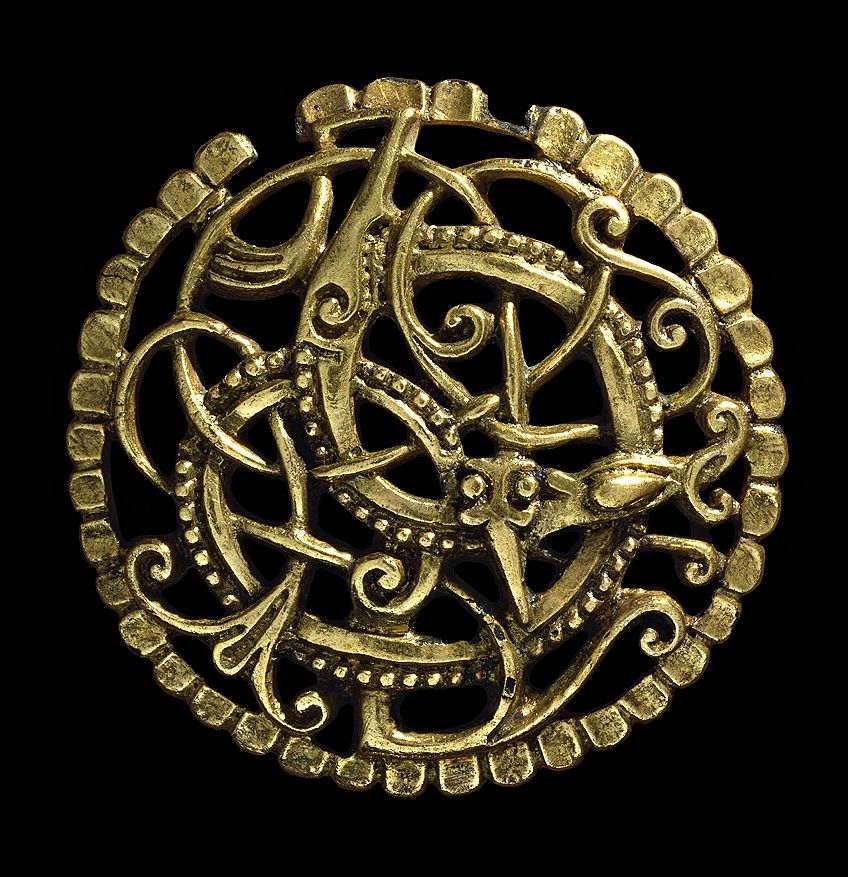
The Viking Age Declines and the Romanesque Age Begins
It is important to note that during the Urnes period there was an increase in the spread of Christianity across Scandinavia. The Viking culture started to decline due to various religious and political upheavals. Traditional Viking Art and its influence lessened, furthermore, with Christianity as the dominant religion and cultural influence the Romanesque Art period started and informed much of how art and architecture should be according to Christian ideals.

The Romanesque Art period is believed to have started around the middle of the 10th Century. It was focused on building more churches, sculptures, and icons for the religious education of the masses. Romanesque architecture was one of the dominant stylistic trends.
The Viking Age certainly left its mark on the Modern Age, the idealistic portrayal of a seemingly barbaric race of men and women has become a pop-cultural trend. From film, live re-enactments, and replicas of various aspects of the Viking culture like weapons, artifacts, and coins. Furthermore, Viking concept art has become a trend among many fans, we see many Viking designs on jewelry including the online space in computer games and graphic design.
The Viking culture was among the most unique cultures in history and each cultural artifact is like a window into the Vikings’ history, their lives, and ideals. The Vikings made their way from the peripheral lands of Europe, reaching its shores, and staking a claim to what they wanted. Although they are remembered as barbaric, the Viking culture had a lot more going for them and no one will forget them as they live on in the tendrils of modern history.
Frequently Asked Questions
What Is Viking Art?
Viking Art occurred during the period of the Viking Age, between 793 and 1066 CE. During this period, when the Vikings invaded other parts of Europe, there was a rise in the dissemination of Viking artwork as well as influences from other countries like England and Ireland. Viking Art is categorized into six dominant styles to emphasize the evolution of the distinct Viking designs seen on their wood carvings and other items like chests, jewelry, as well as runic stones.
What Were the Styles of Viking Art?
There are six primary Viking styles, each one named after a specific area where a notable item was found. The six styles are, namely, Oseberg Style (c. 775 – 875 CE), Borre (c. 850 – 975 CE), Jellinge (c. 900 – 975 CE), Mammen (c. 960 – 1000/1025 CE), Ringerike (c. 990 – 1050 CE), and Urnes (c. 1050 – 1125 CE).
What Are the Characteristics of Viking Art?
There are various characteristic features of Viking Art that are notable across all six artistic styles, namely two distinctive motifs called the “Gripping Beast” and “Ribbon Animal”. These are beast-like creatures that appear to hold on, or grip, to the borders of the composition, but over time this beast also appears lion-like. There are also snake-like creatures that coil themselves around the beast and other ribbon-like motifs that appear as foliage. Other characteristics include functionality, Viking designs are usually on items utilized for everyday living and it has been considered that Viking artwork is not as much “art for art’s sake” as we see in so many other cultures.
Isabella studied at the University of Cape Town in South Africa and graduated with a Bachelor of Arts majoring in English Literature & Language and Psychology. Throughout her undergraduate years, she took Art History as an additional subject and absolutely loved it. Building on from her art history knowledge that began in high school, art has always been a particular area of fascination for her. From learning about artworks previously unknown to her, or sharpening her existing understanding of specific works, the ability to continue learning within this interesting sphere excites her greatly.
Her focal points of interest in art history encompass profiling specific artists and art movements, as it is these areas where she is able to really dig deep into the rich narrative of the art world. Additionally, she particularly enjoys exploring the different artistic styles of the 20th century, as well as the important impact that female artists have had on the development of art history.
Learn more about Isabella Meyer and the Art in Context Team.
Cite this Article
Isabella, Meyer, “Viking Art – The History of Norse and Viking Artwork.” Art in Context. June 2, 2021. URL: https://artincontext.org/viking-art/
Meyer, I. (2021, 2 June). Viking Art – The History of Norse and Viking Artwork. Art in Context. https://artincontext.org/viking-art/
Meyer, Isabella. “Viking Art – The History of Norse and Viking Artwork.” Art in Context, June 2, 2021. https://artincontext.org/viking-art/.


